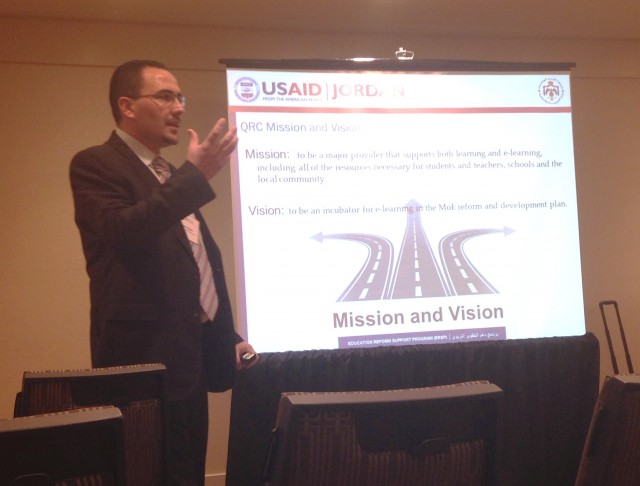[vc_row][vc_column width=”1/1″][vc_column_text]
E-learning in Jordan needs strong push for change
By Maggie Farrand
[/vc_column_text][/vc_column][/vc_row][vc_row][vc_column width=”2/3″][vc_column_text]

Toronto, Canada – Nilhan Siam found the best way to ensure commitment from the Jordanian participants in his e-learning course development program: nagging. He might not be proud of it, but he knows that’s what it takes.
Thanks to his diligence and unusual technique, 25 participants recently completed the one-year program and presented their 10 new e-learning courses to the Jordanian Ministry of Education. They are now live on the Ministry’s e-learning portal called EduWave.
Siam is a staff member in Jordan with Creative’s Education Reform Support Program (ERSP), which partnered with Seward Incorporated, a U.S.-based organization providing custom e-learning and e-business solutions, to build a foundation for e-learning course development.
The process proved difficult, admitted Siam at last week’s Comparative and International Education Society (CIES) conference held in Toronto.
“But if you are committed, you will achieve the outcomes,” he said.
At the panel titled “E-learning design and development capacity building: Lessons learned from ERSP,” Siam joined Seward staff – David Porcaro, Matt Finholt-Daniel and Greg Sales – to present the main findings of the e-learning development project, and provide guidance and advice for future e-learning initiatives. Siam shared his favorite nagging tactics: repeated phone calls to late or absent participants; regular and frequent attendance sheets; and written commitment letters from the participants’ supervisors.
The one-year program consisted of six, one week courses that gradually introduced the participants to phases of e-learning course development, and ultimately facilitated the creation of their own using the program Articulate Storyline. Participants were a mix of programmers and instructional design experts.
Sessions were led by Creative and Seward staff, as well as subject matter experts. For the session on graphic design, for example, the team brought in a graphic artist so they could learn about image resizing and basic design skills; when they talked coding and programming, they brought in a topic expert.
The panelists noted that while teamwork was essential to this process, it took time for people to begin working together. And it also required a lot of effort to ensure they were positive and constructive in their teams. While e-learning was part of some participants’ job descriptions, for others, it was not, making it harder to motivate them and keep them interested in the process.
The course included regular peer reviews, which allowed each team to share their own lessons and for other teams to offer constructive feedback for improvement. Eventually, each team presented their near-final e-learning course to teachers and Ministry staff for review – and even put the course to use in a classroom.
Regular meetings with Ministry staff ensured that objectives were being met, and Ministry staff were satisfied with the progress of the program. Those meetings were their chance to voice concerns, but also ensured buy-in and support from Ministry leadership.
“Going forward,” Porcaro said, “online learning in Jordan really needs a strong driver for change. There isn’t that momentum or solid leadership.”
In fact, in the four years since Creative began the USAID-funded Education Reform Support Program, Jordan has had 12 Ministers of Education. The frequent change in leadership has made it tough for participants to feel motivated.
In spite of the frustrations, there was also a tremendous amount of growth, said Greg Sales, CEO of Seward. “We would hope the Ministry recognizes that, takes advantage of that and looks for opportunities to grow it.”
[/vc_column_text][/vc_column][vc_column width=”1/12″][/vc_column][vc_column width=”1/4″][vc_widget_sidebar sidebar_id=”sidebar-primary”][/vc_column][/vc_row]